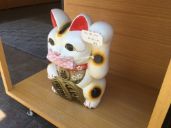A cat that saves lives
The most eye-catching part of the Lucky Cat is most certainly its paw. For many Westerners, the cat seems to be waving. However, we ought not to judge a book by its cover: the cat is not waving at all. Instead the cute and trustworthy companion’s goal is very different. Good news: the Cat's gesture represents luck!
There are many stories circulating about the origins of the cat. The most well-known story dates back to Tokugawa Japan (1603-1868). In an old temple, there lived a Japanese man. The man found a white stray cat and took it in. One day a nobleman passed by the temple, when it suddenly started raining heavily. He hid underneath a tree, but the cat beckoned him to brave the rainfall to hide in the temple. As he walked away from the tree, it got hit by lightning. The nobleman saw the cat’s beckoning as a sign that saved his life. He became the patron of the temple, and the beckoning cat became a symbol of luck in Japan.[cf]
Thus, the cat’s beckoning became associated with good fortune. So how does a cat beckon, you might wonder. In Japan, the gesture of beckoning differs from the West: beckoning is done with a raised hand, showing the back of the hand, whereas, for instance, the Dutch raise the palm of the hand upwards. The origin story of the cat depicted here is one of the most popular ones, but other versions exist. Often, these also focus on the cat helping someone by beckoning, thus bringing good fortune to a human’s life.
The difference in the beckoning gesture explains the confusion many Westerners have when they see the Lucky Cat, but upon closer inspection, a good eye will spot even more differences and peculiarities concerning the Lucky Cat. For instance, some cats have their left paw raised, whereas others have their right paw raised. The left paw up is said to bring in wealth, and the right one is said to bring in good luck.[cf] However, there is probably not one correct answer for this.
The Lucky Cats come in different shapes and colors, and they are not always made of the same material. Let us take a closer look at these features.



